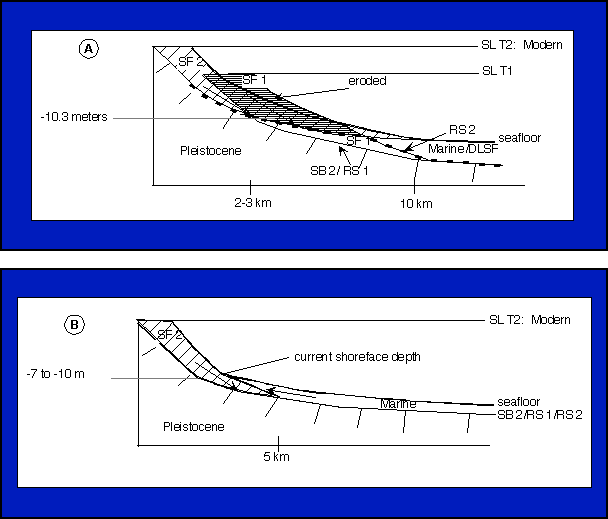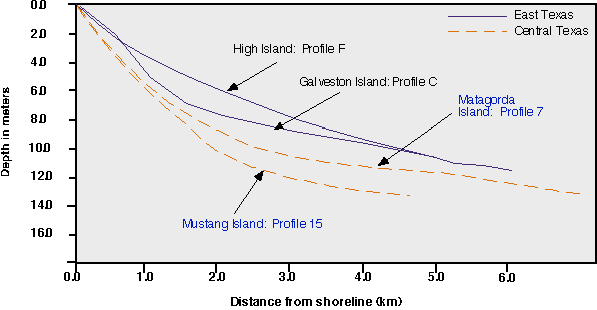Preservation potential of coastal lithosomes
Central Texas:
The preservation potential of coastal lithosomes during the transgression is related
to the amount of accommodation space, sediment supply, and the rate of sea-level rise. Of
all factors, accommodation space is the most critical for lithosome preservation.
High accommodation existed within incised fluvial valleys (profiles 1-4, 6-7,
and 12). A rapid sea-level rise associated with ravinement surface 2 drowned a significant
portion of shoreface 1 sediments below the depth of transgressive ravinement. Low
accommodation space existed on interfluvial highs (profile 10). Transgressive
ravinement removed all shoreface 1 sediments across these profiles. The process of
transgressive ravinement across central Texas is shown in (A) below.

Diagrammatic representation of ravinement across central Texas (A) and east Texas (B). A)
As sea-level rises, wave erosion ravines a portion of shoreface 1 (hatched area). A portion
of shoreface 1 is preserved because it is located below the depth of shoreface ravinement.
The highstand systems tract of central Texas is prograding and may have a high
preservation potential given a rapid sea-level rise.
East Texas versus central Texas:
The east Texas shoreface is currently backstepping with marine sediments
onlapping shoreface 2 sediments (Figure B above). The east Texas shoreface is out-of-
phase with the central Texas shoreface, in that the east Texas shoreface is transgressive
whereas the central Texas shoreface is progradational. This is due to a low sand sediment
supply across east Texas, longshore transport of sands from east Texas to central Texas,
and the steeper gradients across central Texas versus east Texas.
Steeper gradients across central Texas are shown below. A higher
accommodation space in central Texas combined with a significant portion of sediment
below the depth of storm wave base suggests that central Texas shoreface has a high
preservation potential. In contrast, the east Texas shoreface extends only to wave base
and, therefore, has a low preservation potential.

- Evolution
of the Central Texas shoreface
-
- Central
Texas versus East Texas shoreface preservation
potential
Offshore
dataset
- Highstand
systems tract
- Lowstand
systems tract
- Transgressive
systems tract
Controlling
factors on shoreline configuration



